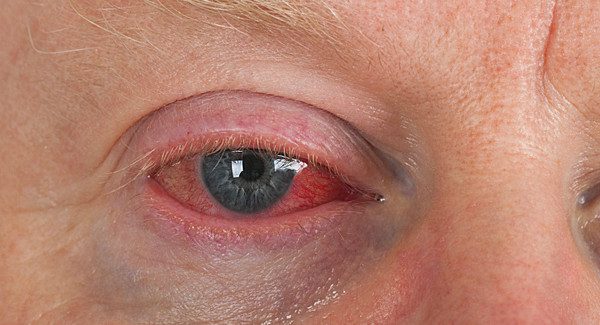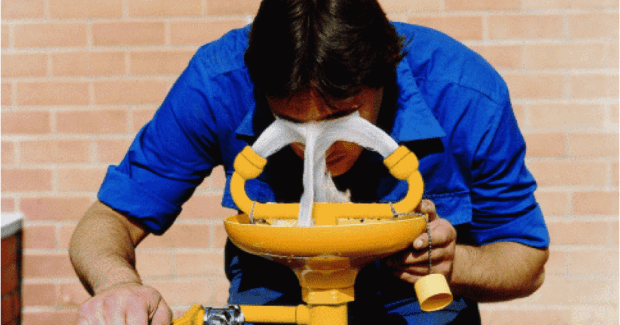How to Identify Safe and Effective Emergency Eyewash — and the Hidden Dangers to Avoid
While the FDA states that ophthalmic drug products should be sterile, ANSI does not require that emergency eyewash solution or its delivery mechanism be sterile. Yet the dangers of administering non-sterile eyewash can have profoundly negative impacts on injured individuals, as well as their employers.
Posted: January 27, 2014
Sterile solution
The 21 CFR 200.50 regulation goes on to state: “Informed medical opinion is in agreement that all preparations offered or intended for ophthalmic use, including preparation for cleansing the eyes, should be sterile. It is further evident that such preparations purport to be of such purity and quality as to be suitable for safe use in the eyes.”
Buffered, sterile saline is the safest ophthalmic flushing fluid for two reasons: first, because its properties are physiologically compatible with human tears and second, because it is devoid of impurities. These attributes minimize the likelihood of irritation, infection or allergic reaction and maximize the chance for a positive outcome.
The manufacture of sterile, buffered saline through aseptic production is rigorous and requires compliance with process controls, inspections and testing. Aseptically filled sterile eyewash is conducted in a clean room using filtration and demanding controls. The result is the type of eyewash that assures 100 percent purity as well as pH and isotonic qualities that match those of the human eye.
The other process used in creating sterile eyewash is gamma irradiation, which also requires manufacture in a clean room. In this case, a non-sterile eyewash bag or bottle is filled with non-sterile fluid; the package is then irradiated as a whole to achieve sterilization. When gamma irradiation is employed on these types of products, the end product may still contain traces of chlorine, boric acid and other harmful chemicals used in manufacturing the fluid. The presence of such residual elements leads to harsher flushing conditions that can cause reddening or burning sensations in the eyes and make a continuous flush extremely uncomfortable.
Buffered, sterile saline is the safest ophthalmic flushing fluid for two reasons: first, because its properties are physiologically compatible with human tears and second, because it is devoid of impurities. These attributes minimize the likelihood of irritation, infection or allergic reaction and maximize the chance for a positive outcome.
STERILE SALINE INTENDED FOR OTHER USES
Significant differences exist even among sterile flushing fluids, and not all are suitable for treating injured eyes. Just because a fluid is FDA approved and carries a NDC does not ensure that it is safe for ophthalmic use. Sterile saline products are registered by the FDA for specific applications.
For example, sterile saline registered as a surgery product may be intended for flushing tissue during surgery. While it is labeled as a medical-grade product, the fluid’s ingredients are not approved for safe use in the eyes. Only sterile saline labeled for ophthalmic use is appropriate to use as emergency eyewash. Other sterile saline solutions may not be pH balanced to match the human eye and can contain elements that are harmful to the eyes’ delicate tissue.
HOW TO QUALIFY SAFE, EFFECTIVE EYEWASH MANUFACTURERS AND DISTRIBUTORS
Employers need a reliable source for safe, effective eyewash. Given the multitude of variables involved, making a selection can prove challenging. Here are the top considerations for qualifying a reliable eyewash supplier:
- The first step to qualifying a source is to check for a NDC, which ensures the product is approved by the FDA. Visit www.FDA.gov/drugs to search the national drug code directory for registered products. Products are listed and are searchable by NDC number, label, brand and manufacturer. In addition, drug recall information and alerts are available here. Be sure to review a product’s recall history. If the manufacturer’s product has been recalled, it signifies that its manufacturing process may not meet FDA requirements and the product may be considered unsafe.
- Next, review the list of ingredients. Look for sterile saline that is produced from 100 percent sterile water from the inception and uses sodium chlorides (salt) only for the purpose of matching the pH to that of the human eye. Beware of solutions containing numerous additives or chemicals which may introduce irritants, allergens or worse. Tamper resistant packaging is the best option to ensure safety and purity.
- It is extremely important to confirm that the fluid is intended for use in the eyes. Ask your distributor, contact the manufacturer directly or visit www.FDA. gov/drugs to search the National Drug Code directory for registered products. Look for the 21 CFR 200.50, which denotes an ophthalmic-grade product.
- Check for a NDC, which ensures the product is approved by the FDA.
- Next, review the list of ingredients. Look for sterile saline that is produced from 100 percent sterile water from the inceptioN.
- Confirm that the fluid is intended for use in the eyes. Ask your distributor, contact the manufacturer directly or visit www. FDA.gov/drugs to search the National Drug Code directory for registered products.
- If the fluid has a New Product Application (NPA), be wary.
- Consider buying products made in the U.S.A.
- Heed expiration dates.
- If the fluid has a New Product Application (NPA), be wary. This means it has been approved as a new product based on paperwork but has not yet undergone and passed thorough audits and testing by the FDA. Products with a NPA have not yet been granted a NDC and the manufacturer or supplier may not be a reliable source.
- Consider buying products made in the U.S. Domestic manufacturing regulations and inspections are more stringent than those in some overseas markets.
- Heed expiration dates. Products are tested and approved to maintain efficacy for a measured length of time and are approved by the FDA according to those parameters. After time, compounds can change form, packaging can degrade and drugs may lose their ability to perform at safe standards. Be sure to renew eyewash solution according to the manufacturer’s guidelines to ensure its sterility and stability.
Despite a decline in eye injuries, such occurrences are still very common in the workplace. National standards and private safety programs alike continue to evolve to provide workers with greater levels of protection. But when accidents happen, an employer’s best defense isto immediately administer the safest and most effective treatment possible.
While the FDA states that ophthalmic drug products should be sterile, ANSI does not require that emergency eyewash solution or its delivery mechanism be sterile. Yet the dangers of administering non-sterile eyewash can have profoundly negative impacts on injured individuals, as well as their employers.
By selecting a reputable manufacturer that supplies FDA-approved, sterile, ophthalmic-grade eyewash, employers benefit from uninterrupted access to a product with superior integrity. That translates into the highest level of care for workers in the event of an eye injury. When workers recover quickly, companies recover quickly, and the safety benefits of exceptional eyewash are clear for everyone to see.
Honeywell Safety Products Inc., 900 Douglas Pike Smithfield, RI 02917, 800-430-5490, www.honeywellsafety.com.





